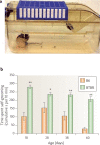Behavioural phenotyping assays for mouse models of autism
- PMID: 20559336
- PMCID: PMC3087436
- DOI: 10.1038/nrn2851
Behavioural phenotyping assays for mouse models of autism
Abstract
Autism is a heterogeneous neurodevelopmental disorder of unknown aetiology that affects 1 in 100-150 individuals. Diagnosis is based on three categories of behavioural criteria: abnormal social interactions, communication deficits and repetitive behaviours. Strong evidence for a genetic basis has prompted the development of mouse models with targeted mutations in candidate genes for autism. As the diagnostic criteria for autism are behavioural, phenotyping these mouse models requires behavioural assays with high relevance to each category of the diagnostic symptoms. Behavioural neuroscientists are generating a comprehensive set of assays for social interaction, communication and repetitive behaviours to test hypotheses about the causes of autism. Robust phenotypes in mouse models hold great promise as translational tools for discovering effective treatments for components of autism spectrum disorders.
Figures




Similar articles
-
Mouse behavioral assays relevant to the symptoms of autism.Brain Pathol. 2007 Oct;17(4):448-59. doi: 10.1111/j.1750-3639.2007.00096.x. Brain Pathol. 2007. PMID: 17919130 Free PMC article. Review.
-
Translational animal models of autism and neurodevelopmental disorders.Dialogues Clin Neurosci. 2012 Sep;14(3):293-305. doi: 10.31887/DCNS.2012.14.3/jcrawley. Dialogues Clin Neurosci. 2012. PMID: 23226954 Free PMC article. Review.
-
Replicable in vivo physiological and behavioral phenotypes of the Shank3B null mutant mouse model of autism.Mol Autism. 2017 Jun 15;8:26. doi: 10.1186/s13229-017-0142-z. eCollection 2017. Mol Autism. 2017. PMID: 28638591 Free PMC article.
-
Mouse models of autism: testing hypotheses about molecular mechanisms.Curr Top Behav Neurosci. 2011;7:187-212. doi: 10.1007/7854_2010_113. Curr Top Behav Neurosci. 2011. PMID: 21225409 Free PMC article.
-
Twenty years of discoveries emerging from mouse models of autism.Neurosci Biobehav Rev. 2023 Mar;146:105053. doi: 10.1016/j.neubiorev.2023.105053. Epub 2023 Jan 20. Neurosci Biobehav Rev. 2023. PMID: 36682425 Review.
Cited by
-
A Need for Consistency in Behavioral Phenotyping for ASD: Analysis of the Valproic Acid Model.Autism Res Treat. 2021 Mar 19;2021:8863256. doi: 10.1155/2021/8863256. eCollection 2021. Autism Res Treat. 2021. PMID: 33828864 Free PMC article. Review.
-
Behavioral impact of maternal allergic-asthma in two genetically distinct mouse strains.Brain Behav Immun. 2017 Jul;63:99-107. doi: 10.1016/j.bbi.2016.09.007. Epub 2016 Sep 10. Brain Behav Immun. 2017. PMID: 27622677 Free PMC article.
-
Neuroimaging endophenotypes in animal models of autism spectrum disorders: lost or found in translation?Psychopharmacology (Berl). 2014 Mar;231(6):1167-89. doi: 10.1007/s00213-013-3200-z. Epub 2013 Jul 14. Psychopharmacology (Berl). 2014. PMID: 23852013 Review.
-
Lack of parvalbumin in mice leads to behavioral deficits relevant to all human autism core symptoms and related neural morphofunctional abnormalities.Transl Psychiatry. 2015 Mar 10;5(3):e525. doi: 10.1038/tp.2015.19. Transl Psychiatry. 2015. PMID: 25756808 Free PMC article.
-
An open-source capacitive touch sensing device for three chamber social behavior test.MethodsX. 2020 Aug 8;7:101024. doi: 10.1016/j.mex.2020.101024. eCollection 2020. MethodsX. 2020. PMID: 32939346 Free PMC article.
References
-
- Happe F, Ronald A. The `fractionable autism triad': a review of evidence from behavioural, genetic, cognitive and neural research. Neuropsychol. Rev. 2008;18:287–304. - PubMed
-
- Kogan MD, et al. Prevalence of parent-reported diagnosis of autism spectrum disorder among children in the US, 2007. Pediatrics. 2009;124:1395–1403. - PubMed
-
- Charman T, et al. Commentary: Effects of diagnostic thresholds and research vs service and administrative diagnosis on autism prevalence. Int. J. Epidemiol. 2009;38:1234–1238. author reply in 38, 1243–1244 (2009) - PubMed
Publication types
MeSH terms
Grants and funding
LinkOut - more resources
Full Text Sources
Other Literature Sources
Medical
Research Materials

